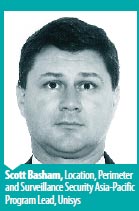Advanced technologies such as biometrics-credentialing kiosks are not just seen in movies;they are gradually appearing in high-risk settings such as at airport customs. Not only do biometrics help screen travelers, they are also exceptional management tools in safeguarding restricted areas and keeping tabs on attendance and payroll records.
Advanced technologies such as biometrics-credentialing kiosks are not just seen in movies;they are gradually appearing in high-risk settings such as at airport customs. Not only do biometrics help screen travelers, they are also exceptional management tools in safeguarding restricted areas and keeping tabs on attendance and payroll records.
Biometrics have not been popular in airport settings until recent years, as a result of the technical barriers that hindered their performance in real-life situations. Often, a biometric reader that performed perfectly in a laboratory test is less impressive in real life, as various environmental and hygienic factors obstruct accurate scans.
 In the case of fingerprint scanning, most optical sensors are configured to look for the presence or absence of total internal reflectance (TIR), which is the phenomenon whereby the interface between glass and air acts as a mirror at certain angles, said Phil Scarfo, Senior VP of Worldwide Sales and Marketing, Lumidigm. “The contact between the skin and the platen defeats the TIR, allowing those points of contact between the finger and the sensor to be imaged. Thus, those points of contact must be complete and visible to enable the conventional sensor to collect a fingerprint image. Optical and electronic sensors simply cannot do this time after time. All too often, 3 to 20 percent of the time, the reader is unable to detect the fingerprint.”
In the case of fingerprint scanning, most optical sensors are configured to look for the presence or absence of total internal reflectance (TIR), which is the phenomenon whereby the interface between glass and air acts as a mirror at certain angles, said Phil Scarfo, Senior VP of Worldwide Sales and Marketing, Lumidigm. “The contact between the skin and the platen defeats the TIR, allowing those points of contact between the finger and the sensor to be imaged. Thus, those points of contact must be complete and visible to enable the conventional sensor to collect a fingerprint image. Optical and electronic sensors simply cannot do this time after time. All too often, 3 to 20 percent of the time, the reader is unable to detect the fingerprint.”
In recent years, multispectral imaging technology has solved the fingerprint-capturing problems that conventional imaging systems encounter in less-than-ideal conditions. “This solution is based on using multiple spectra of light and advanced polarization techniques to extract unique fingerprint characteristics from both the surface and subsurface of the skin,” Scarfo said.
 As airlines and airports work to balance traveler convenience with the need for security, they will increasingly integrate advanced biometricsbased identity authentication technologies into the growing range of self-service processes within air travel, such as passenger and baggage check-in kiosks, said Scott Basham, Location, Perimeter and Surveillance Security Asia-Pacific Program Lead, Unisys. “This is because self-service processes have extended deeper into the air travel cycle — from online flight reservations to today's passenger and luggage check-in kiosks at domestic airports just prior to boarding a flight.”
As airlines and airports work to balance traveler convenience with the need for security, they will increasingly integrate advanced biometricsbased identity authentication technologies into the growing range of self-service processes within air travel, such as passenger and baggage check-in kiosks, said Scott Basham, Location, Perimeter and Surveillance Security Asia-Pacific Program Lead, Unisys. “This is because self-service processes have extended deeper into the air travel cycle — from online flight reservations to today's passenger and luggage check-in kiosks at domestic airports just prior to boarding a flight.”
Staff and Crew Management
 In “Recommended Security Guidelines for Airport Planning, Design and Construction” revised by the US Transportation Security Administration in May, while the use of biometrics is not a federal requirement for US airports, the higher degree of security is recommended for strategically significant facilities or high-risk portals.
In “Recommended Security Guidelines for Airport Planning, Design and Construction” revised by the US Transportation Security Administration in May, while the use of biometrics is not a federal requirement for US airports, the higher degree of security is recommended for strategically significant facilities or high-risk portals.
Commonly used access control features that tie in with time anddual-authentication process, which includes a smart card with a photo ID and biometrics, said Scott Mahnken, VP of Marketing, Bio-Key International. “Depending on the life cycle of the access control system installed, incorporating time and attendance into access control is a logical step in the upgrading/ replacement process,” said Mark Moscinski, VP of Safety and Security, System Development Integration.
 Restricting access for aviation staff can be easily configured by applying biometrics credentialing to sensitive entry points. For unsupervised access to high risk areas, biometrics clearly offer a more secure solution, Basham said. “But care must be taken to ensure that the biometrics cannot be circumvented — either through biometric spoofing or tailgating, where multiple people enter at the same time without verifying their separate identities.”
Restricting access for aviation staff can be easily configured by applying biometrics credentialing to sensitive entry points. For unsupervised access to high risk areas, biometrics clearly offer a more secure solution, Basham said. “But care must be taken to ensure that the biometrics cannot be circumvented — either through biometric spoofing or tailgating, where multiple people enter at the same time without verifying their separate identities.”
“At Yeager Airport in West Virginia, hand geometry readers have been used since 2001, restricting access to the control tower located in the airport terminal and also to the HVAC system and other sensitive equipment,” said , VP of International Sales, Ingersoll Rand Security Technologies. “The control tower doors are opened about every five minutes around the clock. The hand readers are all networked to the airport's central security system.” 
Staff's time-and-attendance records can be simplified as well. “Biometrics are often at the front end for time-andattendance systems in all types of industries, including transportation venues,” Diedam said. “Contrary to using badges, sign-ins or other ways of tracking employees, a biometric reader assures that no employee can punch in for another, eliminating time fraud and reducing payroll costs. This is why so many organizations now employ biometrics; for instance, at the Miami International Airport, the hand punch terminals take time and attendance even for janitorial services.”
Eliminating “buddy punching” is only part of the reason that many want to upgrade, Scarfo observed. “Biometric time-and-attendance systems also prove to be more cost-effective in the long run. Within three to five years, biometric solutions become break-even with plastic cards because of the associated costs with cartridge and printer replacements, as well as the support and management of the system.” 
“We've received many requests for facial-recognition technology for airport employees,” said Aluisio Figueiredo, COO of Intelligent Security Systems. “The main factor is that it is not as intrusive as iris and fingerprint scanning. However, the drawback is that equipment setup must be in accordance with the environment; cameras must be placed in specific areas under specified lighting to ensure accurate readings. This technology cannot be set up just anywhere.” The technology can be installed in both large- and smallscale airports, as it is affordable and can be implemented according to various planning needs and available budgets.
Dangers Screened Out
For external screening of travelers coming into or leaving the country, biometric scanning does provide double prevention against possible security breaches. In some airports, a database of collected personal biometrics data is integrated and connected to government databases for quick referencing and tracking of suspicious persons. “The database can be connected to a similar installment, such as the FBI's identification system, or it can be maintained independently in the cloud,” Mahnken said.
Since 2002 in Europe, internal and external security systems in many European airports have already been interfaced with government databases to ensure air travel safety, said Arjan Bouter, International Sales Manager, Nedap Security Management.